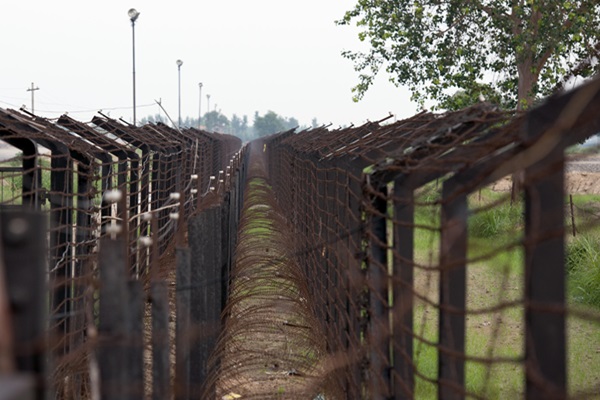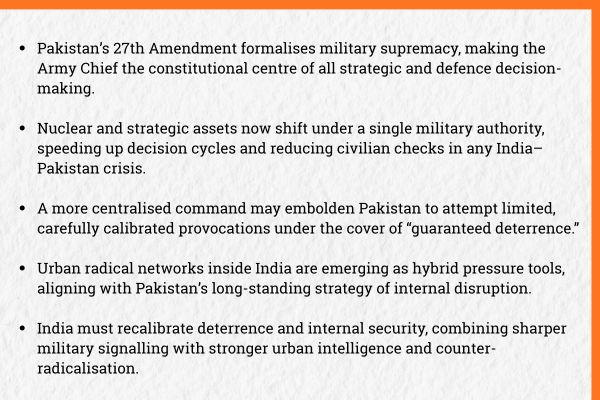.png)
Pakistan’s 27th Amendment: Constitutionalising the Deep State
The future of deterrence and crisis escalation is shifting as Pakistan’s 27th Amendment cements the army’s dominance, tightening nuclear control and altering the risks India must navigate.


Lt Gen Syed Ata Hasnain is a former Commander of India’s Kashmir Corps and Chancellor of the Central University of Kashmir.
November 26, 2025 at 6:44 AM IST
The 27th Constitutional Amendment in Pakistan is not just another moment in its military-dominated history; it is a structural redesign of the state. Unlike past coups enforced through force, this change arrived through Parliament, clothed in legality and constitutional legitimacy. Yet in substance, it goes further than any previous intervention. It formally converts the army from being the most powerful institution into the constitutional fulcrum of the state.
By granting the Army Chief the concurrent role of Chief of Defence Forces—with formal command over the Navy and Air Force—the Amendment eliminates inter-service balance and elevates the army as the singular pivot of military authority. Even more significant is the establishment of a National Strategic Command, which places Pakistan’s strategic and nuclear assets under direct army control, effectively sidelining the earlier National Command Authority. Civilian oversight, whatever existed, has been replaced by concentrated military stewardship under a single office.
This has direct implications for crisis situations. Decision cycles in Pakistan during conflict will now be faster, more centralised and less moderated by political or institutional checks. In a crisis with India, the same institution that feels threatened, calculates risk and controls escalation tools also dominates the constitutional chain of command.
The separation between political judgement and military instinct—never very robust in Pakistan—has been further eroded. Yet this profound transformation has yet to receive sustained attention in India, where the national conversation has been absorbed by state elections, constitutional litigation, and the shock of incidents such as the Delhi car blast of 10 November. Important as those are, they have effectively diverted attention on a most significant structural shift across the border with direct consequences for Indian security.
The US Lens
The muted reaction of the US and other Western powers is not accidental. It reflects a clear hierarchy of interests. Under Trump 2.0, Washington has embraced a more openly transactional engagement with Pakistan. Islamabad remains relevant as a logistical corridor to Afghanistan and Central Asia, a mediator in Gulf politics, a potential hub for critical minerals, and an occasional balancing instrument in the wider China contest. In this calculus, a Pakistan with a centralised, predictable power structure appears more “manageable” than a politically fragmented system.
In Pakistan’s public view the US is not a very popular entity. From this perspective, the consolidation of authority under the army is viewed less as democratic regression and more as institutional efficiency. External actors seldom judge Pakistan’s internal evolution through normative lenses; their concern is that nuclear controls remain intact and the state does not collapse. A constitutionally empowered military, in their assessment, offers greater predictability than unstable civilian rule.
Pakistan’s military leadership clearly understands this. The 27th Amendment signals externally that the army is the only dependable strategic interlocutor. It subtly communicates that Pakistan’s stability, its nuclear stewardship, and even its crisis behaviour with India are secured through military continuity. Such validation emboldens Rawalpindi to believe that it can calibrate confrontation with India, attract international attention, and still retain Western acceptance. This is why India’s interpretation must be absolutely realistic.

Pakistan’s Escalation Playbook
This opens the door to more carefully designed, limited confrontations. The deep state may feel emboldened to test India with incidents that hover just below the threshold at which New Delhi is comfortable escalating, counting on Western calls for restraint to cap the crisis while Pakistan reaps the political dividend of renewed centrality. The risk for India is not only miscalculation; it is the possibility that Pakistan has begun to believe its own narrative of having structurally deterred India by virtue of its nuclear arsenal and hyper-centralised command.
India’s answer cannot be to slide back into passivity. Nor is rhetorical toughness sufficient. The reality is that any escalation choice India makes in the future will be read not just in Islamabad and Rawalpindi, but in Washington, Beijing, Riyadh and the wider international community. India needs the capacity, if forced, to choose an escalatory response that is precise and limited yet serious enough to unsettle Pakistan’s leadership and disturb international complacency. That requires doctrine, capabilities and political preparation. The time when India could rely on lowest-risk options and still shape the strategic environment has probably already passed. It surely cannot be of the variety adopted by the Hamas group to garner international focus by its actions on 7 October, 2023.
Urban Radical Networks
Viewed in isolation, each cell looks like a local law-and-order challenge. Viewed collectively, they resemble the skeleton of a more ambitious design; to create pockets of ideological readiness that can be activated to inflame communal tensions, generate sporadic violence, undermine trust in institutions, or amplify divisive narratives at moments of strategic choice. Whether or not Islamabad is directly controlling them, the pattern aligns all too comfortably with the logic of Pakistan’s deep state—to constantly probe Indian resilience, create distractions, and manufacture controlled internal crises that complicate India’s external freedom of manoeuvre.
The ingenuity of such an approach lies precisely in its ambiguity. It allows Pakistan’s security establishment to signal risk and maintain leverage without obvious fingerprints. It shifts some of the contest away from the Line of Control and international border into India’s urban spaces, information domain and communal psychology. For Indian practitioners of counter-terrorism, proxy war and information security, this demands a conceptual upgrade. The battlefield is not only physical territory or cyberspace; it is also trust between communities and confidence in the state’s ability to pre-empt manipulation.
New Strategic Grammar
For India, the task is two-fold. It must reinforce deterrence at the military and diplomatic levels, through capabilities, signalling and sustained war-gaming that honestly examines risk rather than avoiding it. And it must harden its internal fabric against hybrid destabilisation—through sharper urban intelligence, nuanced counter-radicalisation, agile legal tools and coherent public communication. Above all, it must accept that Pakistan’s deep state is unlikely to voluntarily abandon its strategy of testing India and seeking international bailouts at each crisis.
India cannot prevent Pakistan’s constitutional militarisation. But it can—and must—adapt its own doctrine, posture and political mindspace to the new strategic environment this creates. Only then will it be possible to deter not merely a Pakistan that threatens, but a Pakistan that constantly probes, provokes and tests.



